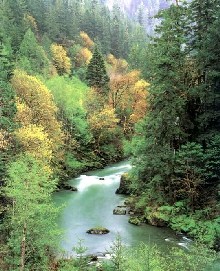| Tools: Save | Print | " target="_blank" class="style1">E-mail | Most Read |
| Take Environment into Account |
| Adjust font size: |
This is the latest move in the series of activities against the project.
Rising in the Tanggula Mountains, the Nujiang River passes through China's Tibet and Yunnan, then Myanmar (where the river is known as Thanlwin) and eventually flows into the Indian Ocean.
In its mid and lower reaches, the natural drop comes to 1,578 meters in a 742-kilometre-long section of the river, which makes it an ideal location for hydroelectric plants.
According to the proposed project, 13 dams will be built on the Nujiang River, the total installed capacity is 21 million kilowatts. And the project is hoped to be a key one supplying electricity for western Yunnan Province.
Supporters claimed that it would not only help satisfy the country's hunger for more power, but also improve the economy and infrastructure of the region, one of the most undeveloped areas in Yunnan Province.
The project arouses remarkable environmental concern.
It is in the Three Parallel Rivers area (including the Jinsha, Nujiang and Lancang rivers), which was added to the World Heritage List as a natural property at the 27th session of the UNESCO's World Heritage Committee in July this year.
The project's defendants believe it is not going to threaten the natural heritage because it is largely located in the mountains at an elevation of over 2,500 meters, even the buffer area is 2,000 meters above sea level, but the water level in the highest reservoir is only 1,570 meters above sea level.
They also think that the hydropower plant, as a source of clean energy, will help local residents use more electricity.
But this hardly persuades the objectors, who maintain that the project will inevitably spoil the ecological integrity of the area, causing disastrous results to species unique to the region.
The river basin, which will be underwater after the dams are built, is the main passageway and refuge for migrating species in Eurasia.
Of 48 known fish types living in the river, more than 30 are peculiar to the region, and four have been listed in the international red paper on wildlife protection. Their life will by threatened most directly. Some of them may disappear forever.
Moreover, the integrity of local ecological system will be destroyed even if only part of the area is put underwater.
The debate attracts extra attention because the Nujiang River is one of the two rivers in China which do not have any artificial conservation, the other one being Yarlung Zangbo River.
This makes the Nujiang River a precious specimen of an ecological system which is free from hydropower exploitation.
In essence, this is a typical incident embodying the conflict between development and environment in the country's economic growth.
Given China's real situation, it is neither possible nor reasonable to put environmental issues before the need for development. But there is also no reason to make the environment a victim of it.
So when the two confront each other in specific cases, the final target should be a win-win solution.
The environmental cost must be calculated as well in assessing any project.
In the Nujiang River's case, the area is far from being thoroughly studied in the geological and ecological terms because of the tough natural conditions there.
And with our current methods, it is hard to estimate the loss in environmental terms as many negative results may take decades to emerge.
According to experts, the Nujiang River is in an area where geological changes occur frequently on a dramatic scale.
Given this, the reservoirs will probably be filled with sediments over scores of years, thus the project might be a total waste.
Before we are able to decide whether the project's revenue is positive or negative when the ecological loss is included, the safe way out of this problem is to delay the project for a while.
And the hydropower plant is far from the only solution to achieve the target for development.
Experts suggested that hydropower plants could be built on rivers where there are already dams, so that the Nujiang River will be spared ecological destruction.
As to poverty-alleviation in this area, ecological tourism could also produce higher incomes, which is more environmentally friendly.
They also suggest the establishment of a State park there to help local residents.
The central authorities have not made any formal decision upon the project though it has been included into the plan to tap hydropower drafted by the provincial government.
Approved or not, the project and the discussion on it is certainly a reminder of two facts:
One, the World Bank statistics said China's GDP will be cut down by 7 to 8 per cent if the loss from environment deterioration is calculated.
Two, countries around the world are pulling down dams on their rivers. The United States, whose Hoover Dam on the Colorado River is one of the world's largest dams, has pulled down more than 500 since 1994.
(China Daily November 6, 2003) |
| Tools: Save | Print | " target="_blank" class="style1">E-mail | Most Read |
 |
| Related Stories |


